Marketing Planning for Sainsbury: Concept, Role, and Evaluation
VerifiedAdded on 2023/06/07
|17
|5089
|497
AI Summary
This marketing planning report discusses the concept and definition of marketing in the 21st century, the role of marketing functions, and an evaluation of how the marketing mix adopted by Sainsbury contributes to the success of the organization in meeting overall business objectives. It also provides recommendations for improvement.
Contribute Materials
Your contribution can guide someone’s learning journey. Share your
documents today.

UNIT 2
Secure Best Marks with AI Grader
Need help grading? Try our AI Grader for instant feedback on your assignments.
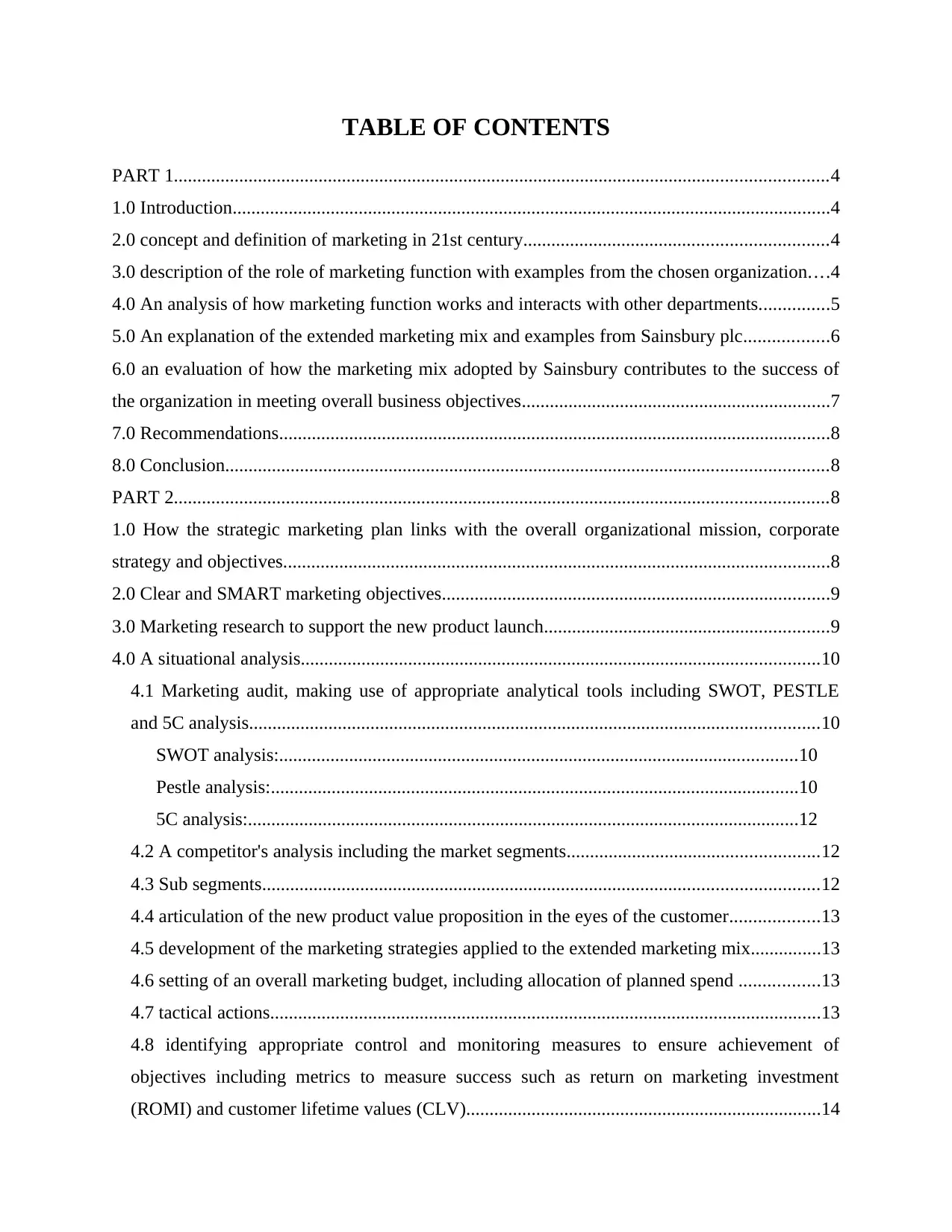
TABLE OF CONTENTS
PART 1............................................................................................................................................4
1.0 Introduction................................................................................................................................4
2.0 concept and definition of marketing in 21st century.................................................................4
3.0 description of the role of marketing function with examples from the chosen organization....4
4.0 An analysis of how marketing function works and interacts with other departments...............5
5.0 An explanation of the extended marketing mix and examples from Sainsbury plc..................6
6.0 an evaluation of how the marketing mix adopted by Sainsbury contributes to the success of
the organization in meeting overall business objectives..................................................................7
7.0 Recommendations......................................................................................................................8
8.0 Conclusion.................................................................................................................................8
PART 2............................................................................................................................................8
1.0 How the strategic marketing plan links with the overall organizational mission, corporate
strategy and objectives.....................................................................................................................8
2.0 Clear and SMART marketing objectives...................................................................................9
3.0 Marketing research to support the new product launch.............................................................9
4.0 A situational analysis...............................................................................................................10
4.1 Marketing audit, making use of appropriate analytical tools including SWOT, PESTLE
and 5C analysis..........................................................................................................................10
SWOT analysis:...............................................................................................................10
Pestle analysis:.................................................................................................................10
5C analysis:......................................................................................................................12
4.2 A competitor's analysis including the market segments......................................................12
4.3 Sub segments.......................................................................................................................12
4.4 articulation of the new product value proposition in the eyes of the customer...................13
4.5 development of the marketing strategies applied to the extended marketing mix...............13
4.6 setting of an overall marketing budget, including allocation of planned spend .................13
4.7 tactical actions......................................................................................................................13
4.8 identifying appropriate control and monitoring measures to ensure achievement of
objectives including metrics to measure success such as return on marketing investment
(ROMI) and customer lifetime values (CLV)............................................................................14
PART 1............................................................................................................................................4
1.0 Introduction................................................................................................................................4
2.0 concept and definition of marketing in 21st century.................................................................4
3.0 description of the role of marketing function with examples from the chosen organization....4
4.0 An analysis of how marketing function works and interacts with other departments...............5
5.0 An explanation of the extended marketing mix and examples from Sainsbury plc..................6
6.0 an evaluation of how the marketing mix adopted by Sainsbury contributes to the success of
the organization in meeting overall business objectives..................................................................7
7.0 Recommendations......................................................................................................................8
8.0 Conclusion.................................................................................................................................8
PART 2............................................................................................................................................8
1.0 How the strategic marketing plan links with the overall organizational mission, corporate
strategy and objectives.....................................................................................................................8
2.0 Clear and SMART marketing objectives...................................................................................9
3.0 Marketing research to support the new product launch.............................................................9
4.0 A situational analysis...............................................................................................................10
4.1 Marketing audit, making use of appropriate analytical tools including SWOT, PESTLE
and 5C analysis..........................................................................................................................10
SWOT analysis:...............................................................................................................10
Pestle analysis:.................................................................................................................10
5C analysis:......................................................................................................................12
4.2 A competitor's analysis including the market segments......................................................12
4.3 Sub segments.......................................................................................................................12
4.4 articulation of the new product value proposition in the eyes of the customer...................13
4.5 development of the marketing strategies applied to the extended marketing mix...............13
4.6 setting of an overall marketing budget, including allocation of planned spend .................13
4.7 tactical actions......................................................................................................................13
4.8 identifying appropriate control and monitoring measures to ensure achievement of
objectives including metrics to measure success such as return on marketing investment
(ROMI) and customer lifetime values (CLV)............................................................................14

5.0 A comprehensive media plan that supports the planned marketing campaign........................14
5.1 a media budget.......................................................................................................................1
5.2 recommendations and rationale for selected and integrated multi media activities within
the set budget that meet the marketing objectives.......................................................................1
5.3 appropriate digital, offline and social media channels for communication...........................1
5.4 full justification for multi-media plan based on quantitative and qualitative criteria............1
REFERENCES................................................................................................................................2
5.1 a media budget.......................................................................................................................1
5.2 recommendations and rationale for selected and integrated multi media activities within
the set budget that meet the marketing objectives.......................................................................1
5.3 appropriate digital, offline and social media channels for communication...........................1
5.4 full justification for multi-media plan based on quantitative and qualitative criteria............1
REFERENCES................................................................................................................................2

PART 1
1.0 Introduction
The report of marketing planning will comprehensively illustrate a detailed marketing
plan. It will explain the concept and definition of marketing in 21st century, role of marketing
functions with examples. Also, the work of marketing functions and how they interact with other
departments will be given. Further, extended marketing mix of the organization and how it
contributes to the success of the organization will be depicted with the help of 7 ps of marketing.
Recommendation for improvement will also be mentioned. The organization taken is Sainsbury
which is a supermarket chain in the united kingdom. It Has a market share of 14% and is ranked
2nd in super market chains in UK (Rauschnabel and et.al., 2022).
2.0 concept and definition of marketing in 21st century
Marketing is the collaboration of several actions that promotes the brand or product of the
organization. In the old times marketing was just about communication of product and brand in
the market, yet in 21st century, marketing includes various small actions or tasks which not only
promotes the product and brand but also does the work of value addition to the organization.
The concept of marketing undertakes the sole belief of bringing customer satisfaction by all
means possible. Marketing is done in a manner that a product brings solution to the customer
rather mare introduction of product. It focuses on product, price, place, promotion, physical
evidence, people, process (Ismail and Zainol, 2018). Which is almost everything about an
organization, to bring the customer satisfaction. Marketing is such a broad term that takes care of
customer experience ever since the customer comes in contact with the brand and till they make
purchase and even beyond that.
3.0 description of the role of marketing function with examples from the
chosen organization
Marketing plays a very crucial role in the growth and development of the organization.
Sainsbury is a supermarket chain which faces several challenges in terms of high competition
and status of relatability in the market place. Marketing function helps the company combat
these challenges and business thrive. Let's understand the few important roles of marketing
functions with examples from Sainsbury's.
1.0 Introduction
The report of marketing planning will comprehensively illustrate a detailed marketing
plan. It will explain the concept and definition of marketing in 21st century, role of marketing
functions with examples. Also, the work of marketing functions and how they interact with other
departments will be given. Further, extended marketing mix of the organization and how it
contributes to the success of the organization will be depicted with the help of 7 ps of marketing.
Recommendation for improvement will also be mentioned. The organization taken is Sainsbury
which is a supermarket chain in the united kingdom. It Has a market share of 14% and is ranked
2nd in super market chains in UK (Rauschnabel and et.al., 2022).
2.0 concept and definition of marketing in 21st century
Marketing is the collaboration of several actions that promotes the brand or product of the
organization. In the old times marketing was just about communication of product and brand in
the market, yet in 21st century, marketing includes various small actions or tasks which not only
promotes the product and brand but also does the work of value addition to the organization.
The concept of marketing undertakes the sole belief of bringing customer satisfaction by all
means possible. Marketing is done in a manner that a product brings solution to the customer
rather mare introduction of product. It focuses on product, price, place, promotion, physical
evidence, people, process (Ismail and Zainol, 2018). Which is almost everything about an
organization, to bring the customer satisfaction. Marketing is such a broad term that takes care of
customer experience ever since the customer comes in contact with the brand and till they make
purchase and even beyond that.
3.0 description of the role of marketing function with examples from the
chosen organization
Marketing plays a very crucial role in the growth and development of the organization.
Sainsbury is a supermarket chain which faces several challenges in terms of high competition
and status of relatability in the market place. Marketing function helps the company combat
these challenges and business thrive. Let's understand the few important roles of marketing
functions with examples from Sainsbury's.
Secure Best Marks with AI Grader
Need help grading? Try our AI Grader for instant feedback on your assignments.
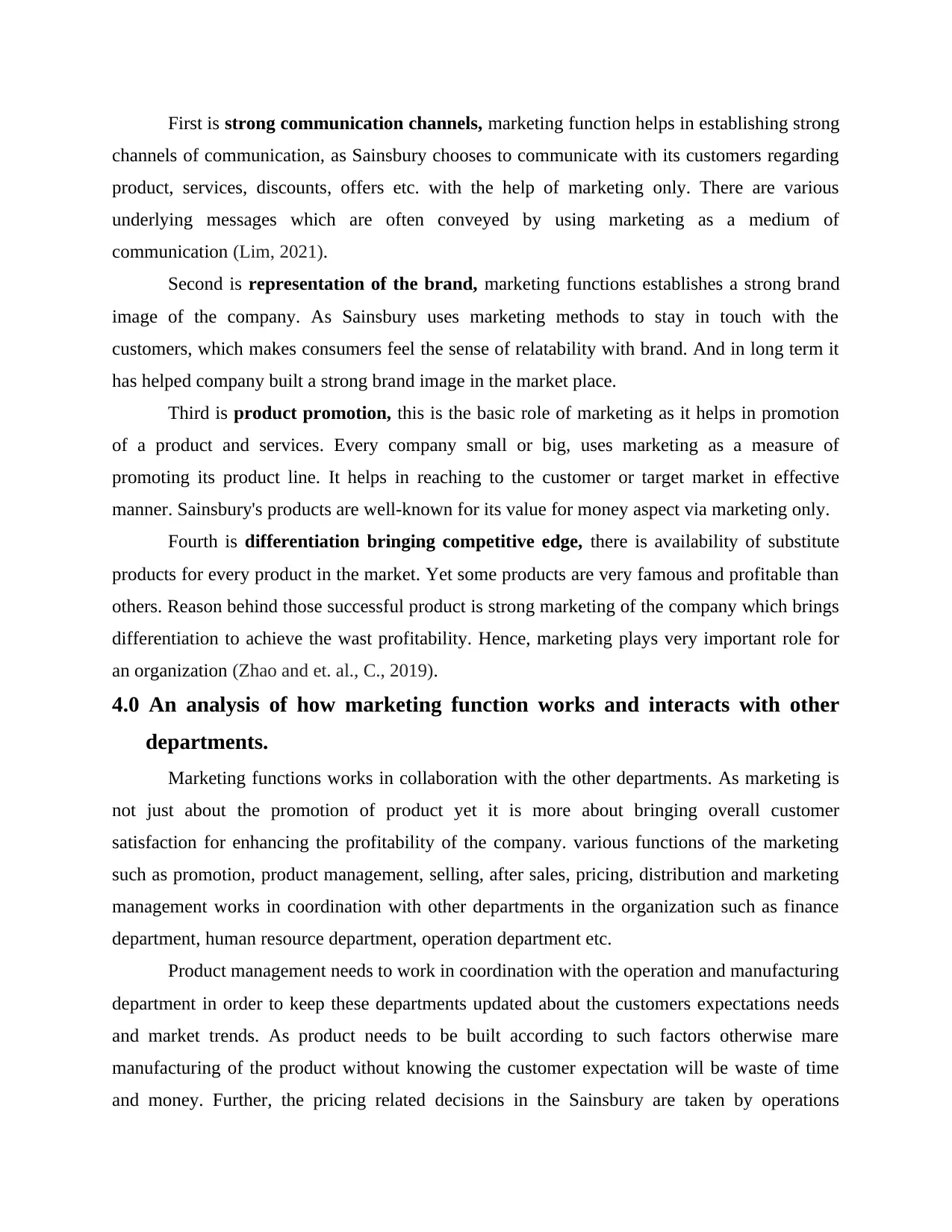
First is strong communication channels, marketing function helps in establishing strong
channels of communication, as Sainsbury chooses to communicate with its customers regarding
product, services, discounts, offers etc. with the help of marketing only. There are various
underlying messages which are often conveyed by using marketing as a medium of
communication (Lim, 2021).
Second is representation of the brand, marketing functions establishes a strong brand
image of the company. As Sainsbury uses marketing methods to stay in touch with the
customers, which makes consumers feel the sense of relatability with brand. And in long term it
has helped company built a strong brand image in the market place.
Third is product promotion, this is the basic role of marketing as it helps in promotion
of a product and services. Every company small or big, uses marketing as a measure of
promoting its product line. It helps in reaching to the customer or target market in effective
manner. Sainsbury's products are well-known for its value for money aspect via marketing only.
Fourth is differentiation bringing competitive edge, there is availability of substitute
products for every product in the market. Yet some products are very famous and profitable than
others. Reason behind those successful product is strong marketing of the company which brings
differentiation to achieve the wast profitability. Hence, marketing plays very important role for
an organization (Zhao and et. al., C., 2019).
4.0 An analysis of how marketing function works and interacts with other
departments.
Marketing functions works in collaboration with the other departments. As marketing is
not just about the promotion of product yet it is more about bringing overall customer
satisfaction for enhancing the profitability of the company. various functions of the marketing
such as promotion, product management, selling, after sales, pricing, distribution and marketing
management works in coordination with other departments in the organization such as finance
department, human resource department, operation department etc.
Product management needs to work in coordination with the operation and manufacturing
department in order to keep these departments updated about the customers expectations needs
and market trends. As product needs to be built according to such factors otherwise mare
manufacturing of the product without knowing the customer expectation will be waste of time
and money. Further, the pricing related decisions in the Sainsbury are taken by operations
channels of communication, as Sainsbury chooses to communicate with its customers regarding
product, services, discounts, offers etc. with the help of marketing only. There are various
underlying messages which are often conveyed by using marketing as a medium of
communication (Lim, 2021).
Second is representation of the brand, marketing functions establishes a strong brand
image of the company. As Sainsbury uses marketing methods to stay in touch with the
customers, which makes consumers feel the sense of relatability with brand. And in long term it
has helped company built a strong brand image in the market place.
Third is product promotion, this is the basic role of marketing as it helps in promotion
of a product and services. Every company small or big, uses marketing as a measure of
promoting its product line. It helps in reaching to the customer or target market in effective
manner. Sainsbury's products are well-known for its value for money aspect via marketing only.
Fourth is differentiation bringing competitive edge, there is availability of substitute
products for every product in the market. Yet some products are very famous and profitable than
others. Reason behind those successful product is strong marketing of the company which brings
differentiation to achieve the wast profitability. Hence, marketing plays very important role for
an organization (Zhao and et. al., C., 2019).
4.0 An analysis of how marketing function works and interacts with other
departments.
Marketing functions works in collaboration with the other departments. As marketing is
not just about the promotion of product yet it is more about bringing overall customer
satisfaction for enhancing the profitability of the company. various functions of the marketing
such as promotion, product management, selling, after sales, pricing, distribution and marketing
management works in coordination with other departments in the organization such as finance
department, human resource department, operation department etc.
Product management needs to work in coordination with the operation and manufacturing
department in order to keep these departments updated about the customers expectations needs
and market trends. As product needs to be built according to such factors otherwise mare
manufacturing of the product without knowing the customer expectation will be waste of time
and money. Further, the pricing related decisions in the Sainsbury are taken by operations
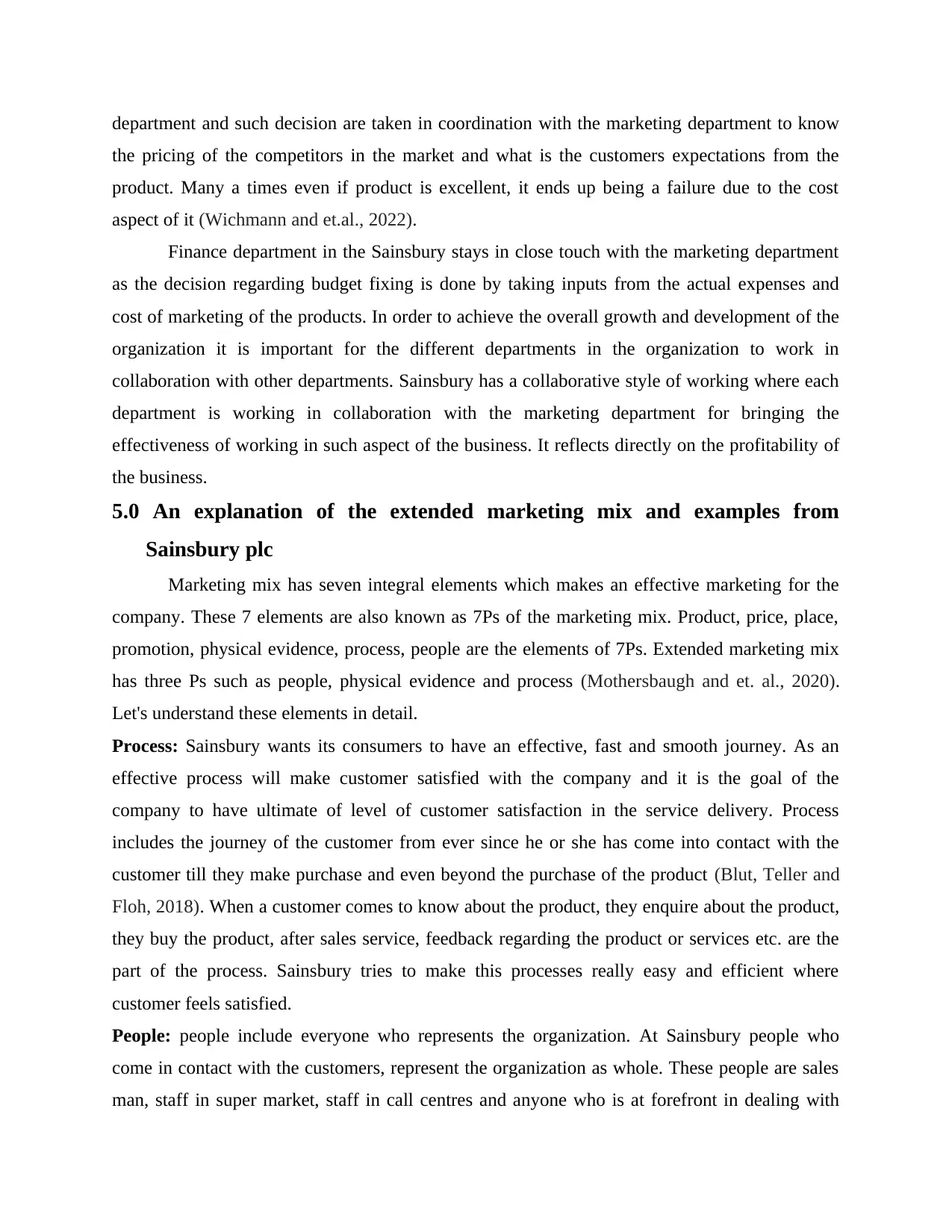
department and such decision are taken in coordination with the marketing department to know
the pricing of the competitors in the market and what is the customers expectations from the
product. Many a times even if product is excellent, it ends up being a failure due to the cost
aspect of it (Wichmann and et.al., 2022).
Finance department in the Sainsbury stays in close touch with the marketing department
as the decision regarding budget fixing is done by taking inputs from the actual expenses and
cost of marketing of the products. In order to achieve the overall growth and development of the
organization it is important for the different departments in the organization to work in
collaboration with other departments. Sainsbury has a collaborative style of working where each
department is working in collaboration with the marketing department for bringing the
effectiveness of working in such aspect of the business. It reflects directly on the profitability of
the business.
5.0 An explanation of the extended marketing mix and examples from
Sainsbury plc
Marketing mix has seven integral elements which makes an effective marketing for the
company. These 7 elements are also known as 7Ps of the marketing mix. Product, price, place,
promotion, physical evidence, process, people are the elements of 7Ps. Extended marketing mix
has three Ps such as people, physical evidence and process (Mothersbaugh and et. al., 2020).
Let's understand these elements in detail.
Process: Sainsbury wants its consumers to have an effective, fast and smooth journey. As an
effective process will make customer satisfied with the company and it is the goal of the
company to have ultimate of level of customer satisfaction in the service delivery. Process
includes the journey of the customer from ever since he or she has come into contact with the
customer till they make purchase and even beyond the purchase of the product (Blut, Teller and
Floh, 2018). When a customer comes to know about the product, they enquire about the product,
they buy the product, after sales service, feedback regarding the product or services etc. are the
part of the process. Sainsbury tries to make this processes really easy and efficient where
customer feels satisfied.
People: people include everyone who represents the organization. At Sainsbury people who
come in contact with the customers, represent the organization as whole. These people are sales
man, staff in super market, staff in call centres and anyone who is at forefront in dealing with
the pricing of the competitors in the market and what is the customers expectations from the
product. Many a times even if product is excellent, it ends up being a failure due to the cost
aspect of it (Wichmann and et.al., 2022).
Finance department in the Sainsbury stays in close touch with the marketing department
as the decision regarding budget fixing is done by taking inputs from the actual expenses and
cost of marketing of the products. In order to achieve the overall growth and development of the
organization it is important for the different departments in the organization to work in
collaboration with other departments. Sainsbury has a collaborative style of working where each
department is working in collaboration with the marketing department for bringing the
effectiveness of working in such aspect of the business. It reflects directly on the profitability of
the business.
5.0 An explanation of the extended marketing mix and examples from
Sainsbury plc
Marketing mix has seven integral elements which makes an effective marketing for the
company. These 7 elements are also known as 7Ps of the marketing mix. Product, price, place,
promotion, physical evidence, process, people are the elements of 7Ps. Extended marketing mix
has three Ps such as people, physical evidence and process (Mothersbaugh and et. al., 2020).
Let's understand these elements in detail.
Process: Sainsbury wants its consumers to have an effective, fast and smooth journey. As an
effective process will make customer satisfied with the company and it is the goal of the
company to have ultimate of level of customer satisfaction in the service delivery. Process
includes the journey of the customer from ever since he or she has come into contact with the
customer till they make purchase and even beyond the purchase of the product (Blut, Teller and
Floh, 2018). When a customer comes to know about the product, they enquire about the product,
they buy the product, after sales service, feedback regarding the product or services etc. are the
part of the process. Sainsbury tries to make this processes really easy and efficient where
customer feels satisfied.
People: people include everyone who represents the organization. At Sainsbury people who
come in contact with the customers, represent the organization as whole. These people are sales
man, staff in super market, staff in call centres and anyone who is at forefront in dealing with
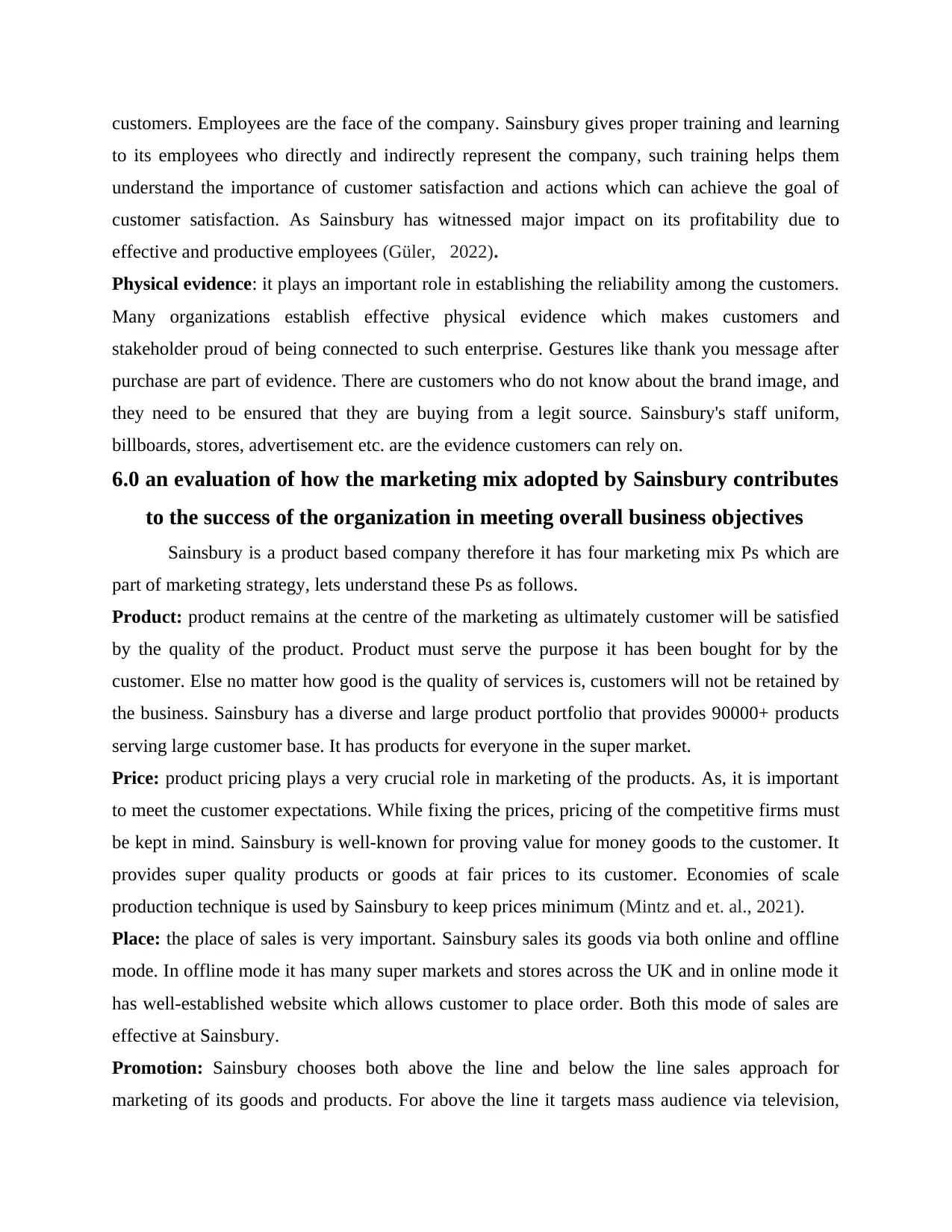
customers. Employees are the face of the company. Sainsbury gives proper training and learning
to its employees who directly and indirectly represent the company, such training helps them
understand the importance of customer satisfaction and actions which can achieve the goal of
customer satisfaction. As Sainsbury has witnessed major impact on its profitability due to
effective and productive employees (Güler, 2022).
Physical evidence: it plays an important role in establishing the reliability among the customers.
Many organizations establish effective physical evidence which makes customers and
stakeholder proud of being connected to such enterprise. Gestures like thank you message after
purchase are part of evidence. There are customers who do not know about the brand image, and
they need to be ensured that they are buying from a legit source. Sainsbury's staff uniform,
billboards, stores, advertisement etc. are the evidence customers can rely on.
6.0 an evaluation of how the marketing mix adopted by Sainsbury contributes
to the success of the organization in meeting overall business objectives
Sainsbury is a product based company therefore it has four marketing mix Ps which are
part of marketing strategy, lets understand these Ps as follows.
Product: product remains at the centre of the marketing as ultimately customer will be satisfied
by the quality of the product. Product must serve the purpose it has been bought for by the
customer. Else no matter how good is the quality of services is, customers will not be retained by
the business. Sainsbury has a diverse and large product portfolio that provides 90000+ products
serving large customer base. It has products for everyone in the super market.
Price: product pricing plays a very crucial role in marketing of the products. As, it is important
to meet the customer expectations. While fixing the prices, pricing of the competitive firms must
be kept in mind. Sainsbury is well-known for proving value for money goods to the customer. It
provides super quality products or goods at fair prices to its customer. Economies of scale
production technique is used by Sainsbury to keep prices minimum (Mintz and et. al., 2021).
Place: the place of sales is very important. Sainsbury sales its goods via both online and offline
mode. In offline mode it has many super markets and stores across the UK and in online mode it
has well-established website which allows customer to place order. Both this mode of sales are
effective at Sainsbury.
Promotion: Sainsbury chooses both above the line and below the line sales approach for
marketing of its goods and products. For above the line it targets mass audience via television,
to its employees who directly and indirectly represent the company, such training helps them
understand the importance of customer satisfaction and actions which can achieve the goal of
customer satisfaction. As Sainsbury has witnessed major impact on its profitability due to
effective and productive employees (Güler, 2022).
Physical evidence: it plays an important role in establishing the reliability among the customers.
Many organizations establish effective physical evidence which makes customers and
stakeholder proud of being connected to such enterprise. Gestures like thank you message after
purchase are part of evidence. There are customers who do not know about the brand image, and
they need to be ensured that they are buying from a legit source. Sainsbury's staff uniform,
billboards, stores, advertisement etc. are the evidence customers can rely on.
6.0 an evaluation of how the marketing mix adopted by Sainsbury contributes
to the success of the organization in meeting overall business objectives
Sainsbury is a product based company therefore it has four marketing mix Ps which are
part of marketing strategy, lets understand these Ps as follows.
Product: product remains at the centre of the marketing as ultimately customer will be satisfied
by the quality of the product. Product must serve the purpose it has been bought for by the
customer. Else no matter how good is the quality of services is, customers will not be retained by
the business. Sainsbury has a diverse and large product portfolio that provides 90000+ products
serving large customer base. It has products for everyone in the super market.
Price: product pricing plays a very crucial role in marketing of the products. As, it is important
to meet the customer expectations. While fixing the prices, pricing of the competitive firms must
be kept in mind. Sainsbury is well-known for proving value for money goods to the customer. It
provides super quality products or goods at fair prices to its customer. Economies of scale
production technique is used by Sainsbury to keep prices minimum (Mintz and et. al., 2021).
Place: the place of sales is very important. Sainsbury sales its goods via both online and offline
mode. In offline mode it has many super markets and stores across the UK and in online mode it
has well-established website which allows customer to place order. Both this mode of sales are
effective at Sainsbury.
Promotion: Sainsbury chooses both above the line and below the line sales approach for
marketing of its goods and products. For above the line it targets mass audience via television,
Paraphrase This Document
Need a fresh take? Get an instant paraphrase of this document with our AI Paraphraser
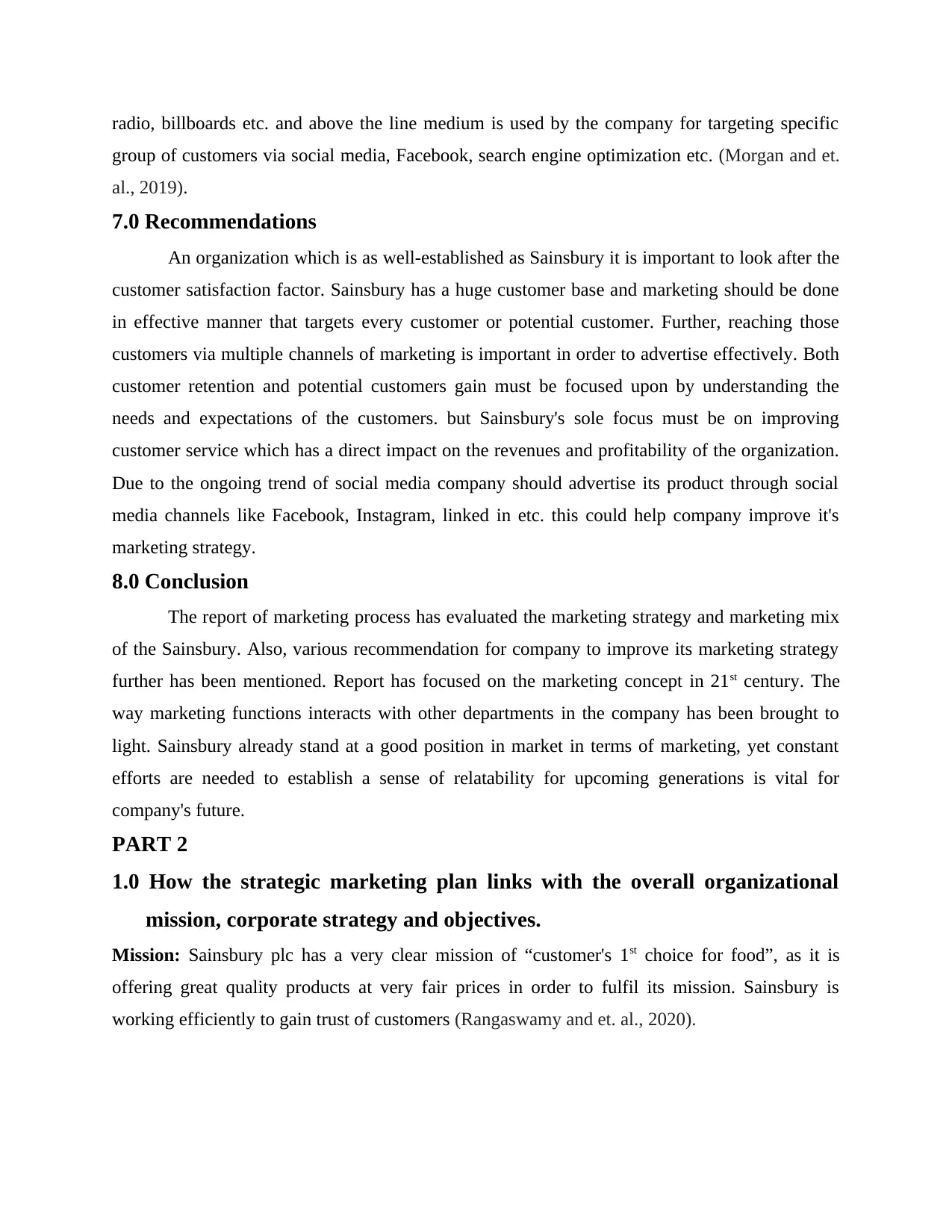
radio, billboards etc. and above the line medium is used by the company for targeting specific
group of customers via social media, Facebook, search engine optimization etc. (Morgan and et.
al., 2019).
7.0 Recommendations
An organization which is as well-established as Sainsbury it is important to look after the
customer satisfaction factor. Sainsbury has a huge customer base and marketing should be done
in effective manner that targets every customer or potential customer. Further, reaching those
customers via multiple channels of marketing is important in order to advertise effectively. Both
customer retention and potential customers gain must be focused upon by understanding the
needs and expectations of the customers. but Sainsbury's sole focus must be on improving
customer service which has a direct impact on the revenues and profitability of the organization.
Due to the ongoing trend of social media company should advertise its product through social
media channels like Facebook, Instagram, linked in etc. this could help company improve it's
marketing strategy.
8.0 Conclusion
The report of marketing process has evaluated the marketing strategy and marketing mix
of the Sainsbury. Also, various recommendation for company to improve its marketing strategy
further has been mentioned. Report has focused on the marketing concept in 21st century. The
way marketing functions interacts with other departments in the company has been brought to
light. Sainsbury already stand at a good position in market in terms of marketing, yet constant
efforts are needed to establish a sense of relatability for upcoming generations is vital for
company's future.
PART 2
1.0 How the strategic marketing plan links with the overall organizational
mission, corporate strategy and objectives.
Mission: Sainsbury plc has a very clear mission of “customer's 1st choice for food”, as it is
offering great quality products at very fair prices in order to fulfil its mission. Sainsbury is
working efficiently to gain trust of customers (Rangaswamy and et. al., 2020).
group of customers via social media, Facebook, search engine optimization etc. (Morgan and et.
al., 2019).
7.0 Recommendations
An organization which is as well-established as Sainsbury it is important to look after the
customer satisfaction factor. Sainsbury has a huge customer base and marketing should be done
in effective manner that targets every customer or potential customer. Further, reaching those
customers via multiple channels of marketing is important in order to advertise effectively. Both
customer retention and potential customers gain must be focused upon by understanding the
needs and expectations of the customers. but Sainsbury's sole focus must be on improving
customer service which has a direct impact on the revenues and profitability of the organization.
Due to the ongoing trend of social media company should advertise its product through social
media channels like Facebook, Instagram, linked in etc. this could help company improve it's
marketing strategy.
8.0 Conclusion
The report of marketing process has evaluated the marketing strategy and marketing mix
of the Sainsbury. Also, various recommendation for company to improve its marketing strategy
further has been mentioned. Report has focused on the marketing concept in 21st century. The
way marketing functions interacts with other departments in the company has been brought to
light. Sainsbury already stand at a good position in market in terms of marketing, yet constant
efforts are needed to establish a sense of relatability for upcoming generations is vital for
company's future.
PART 2
1.0 How the strategic marketing plan links with the overall organizational
mission, corporate strategy and objectives.
Mission: Sainsbury plc has a very clear mission of “customer's 1st choice for food”, as it is
offering great quality products at very fair prices in order to fulfil its mission. Sainsbury is
working efficiently to gain trust of customers (Rangaswamy and et. al., 2020).
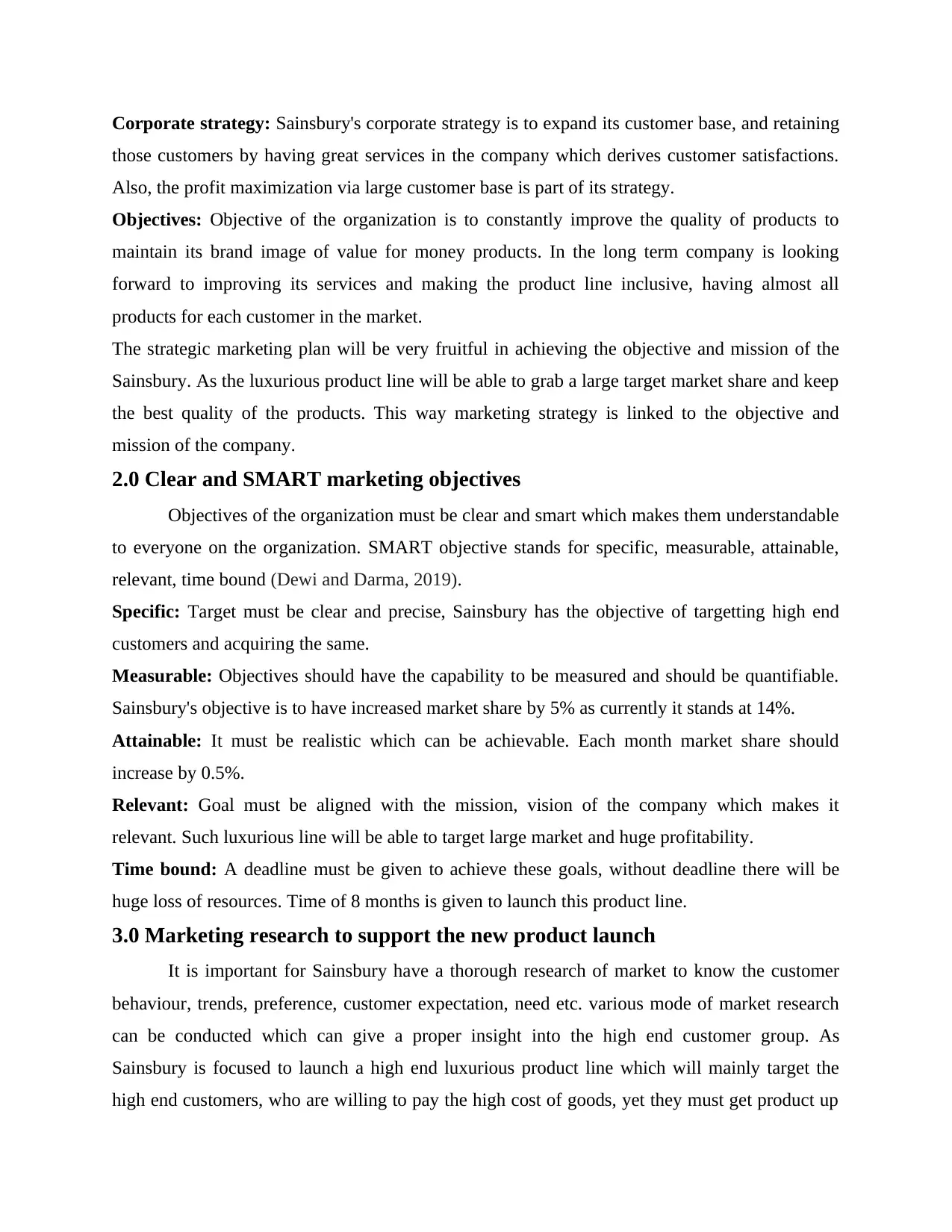
Corporate strategy: Sainsbury's corporate strategy is to expand its customer base, and retaining
those customers by having great services in the company which derives customer satisfactions.
Also, the profit maximization via large customer base is part of its strategy.
Objectives: Objective of the organization is to constantly improve the quality of products to
maintain its brand image of value for money products. In the long term company is looking
forward to improving its services and making the product line inclusive, having almost all
products for each customer in the market.
The strategic marketing plan will be very fruitful in achieving the objective and mission of the
Sainsbury. As the luxurious product line will be able to grab a large target market share and keep
the best quality of the products. This way marketing strategy is linked to the objective and
mission of the company.
2.0 Clear and SMART marketing objectives
Objectives of the organization must be clear and smart which makes them understandable
to everyone on the organization. SMART objective stands for specific, measurable, attainable,
relevant, time bound (Dewi and Darma, 2019).
Specific: Target must be clear and precise, Sainsbury has the objective of targetting high end
customers and acquiring the same.
Measurable: Objectives should have the capability to be measured and should be quantifiable.
Sainsbury's objective is to have increased market share by 5% as currently it stands at 14%.
Attainable: It must be realistic which can be achievable. Each month market share should
increase by 0.5%.
Relevant: Goal must be aligned with the mission, vision of the company which makes it
relevant. Such luxurious line will be able to target large market and huge profitability.
Time bound: A deadline must be given to achieve these goals, without deadline there will be
huge loss of resources. Time of 8 months is given to launch this product line.
3.0 Marketing research to support the new product launch
It is important for Sainsbury have a thorough research of market to know the customer
behaviour, trends, preference, customer expectation, need etc. various mode of market research
can be conducted which can give a proper insight into the high end customer group. As
Sainsbury is focused to launch a high end luxurious product line which will mainly target the
high end customers, who are willing to pay the high cost of goods, yet they must get product up
those customers by having great services in the company which derives customer satisfactions.
Also, the profit maximization via large customer base is part of its strategy.
Objectives: Objective of the organization is to constantly improve the quality of products to
maintain its brand image of value for money products. In the long term company is looking
forward to improving its services and making the product line inclusive, having almost all
products for each customer in the market.
The strategic marketing plan will be very fruitful in achieving the objective and mission of the
Sainsbury. As the luxurious product line will be able to grab a large target market share and keep
the best quality of the products. This way marketing strategy is linked to the objective and
mission of the company.
2.0 Clear and SMART marketing objectives
Objectives of the organization must be clear and smart which makes them understandable
to everyone on the organization. SMART objective stands for specific, measurable, attainable,
relevant, time bound (Dewi and Darma, 2019).
Specific: Target must be clear and precise, Sainsbury has the objective of targetting high end
customers and acquiring the same.
Measurable: Objectives should have the capability to be measured and should be quantifiable.
Sainsbury's objective is to have increased market share by 5% as currently it stands at 14%.
Attainable: It must be realistic which can be achievable. Each month market share should
increase by 0.5%.
Relevant: Goal must be aligned with the mission, vision of the company which makes it
relevant. Such luxurious line will be able to target large market and huge profitability.
Time bound: A deadline must be given to achieve these goals, without deadline there will be
huge loss of resources. Time of 8 months is given to launch this product line.
3.0 Marketing research to support the new product launch
It is important for Sainsbury have a thorough research of market to know the customer
behaviour, trends, preference, customer expectation, need etc. various mode of market research
can be conducted which can give a proper insight into the high end customer group. As
Sainsbury is focused to launch a high end luxurious product line which will mainly target the
high end customers, who are willing to pay the high cost of goods, yet they must get product up
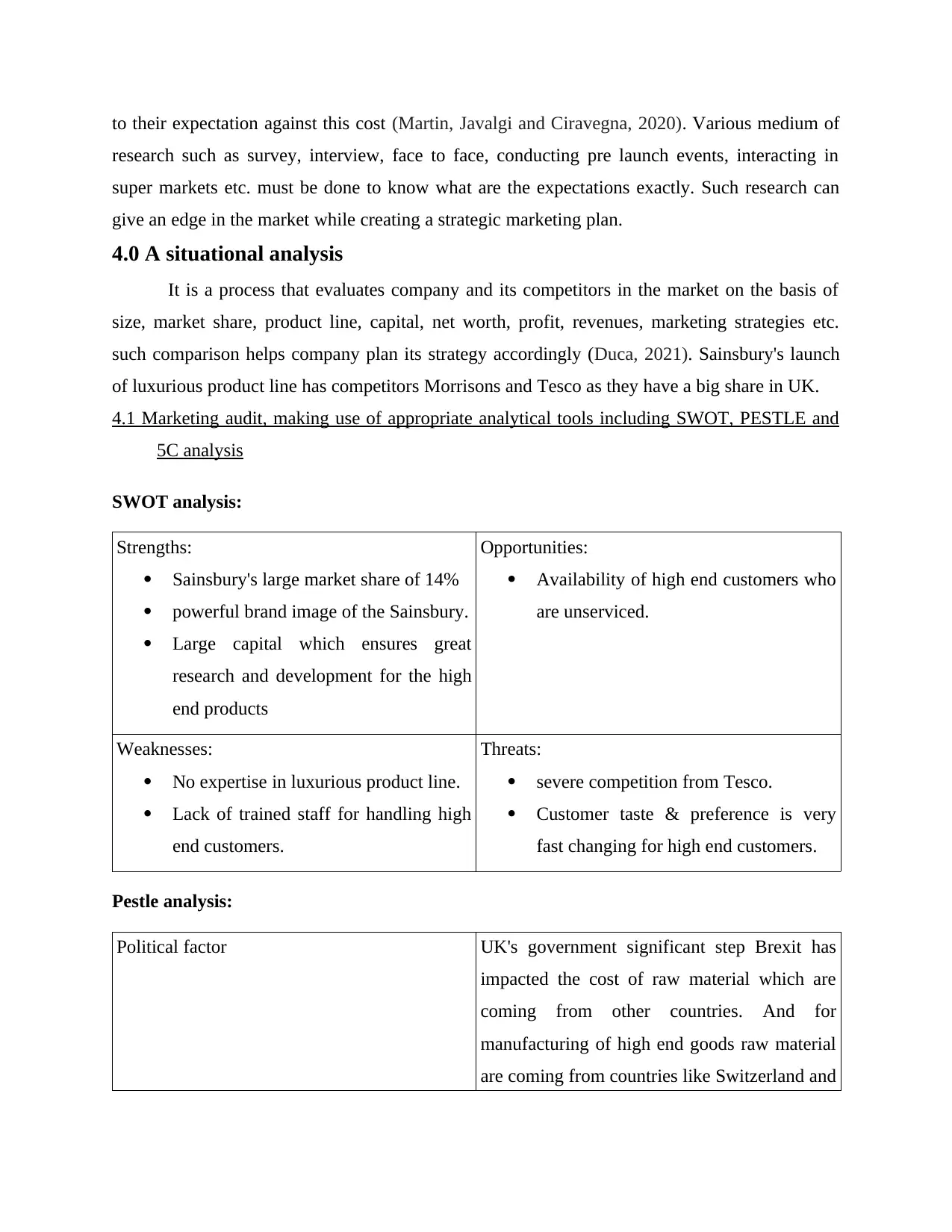
to their expectation against this cost (Martin, Javalgi and Ciravegna, 2020). Various medium of
research such as survey, interview, face to face, conducting pre launch events, interacting in
super markets etc. must be done to know what are the expectations exactly. Such research can
give an edge in the market while creating a strategic marketing plan.
4.0 A situational analysis
It is a process that evaluates company and its competitors in the market on the basis of
size, market share, product line, capital, net worth, profit, revenues, marketing strategies etc.
such comparison helps company plan its strategy accordingly (Duca, 2021). Sainsbury's launch
of luxurious product line has competitors Morrisons and Tesco as they have a big share in UK.
4.1 Marketing audit, making use of appropriate analytical tools including SWOT, PESTLE and
5C analysis
SWOT analysis:
Strengths:
Sainsbury's large market share of 14%
powerful brand image of the Sainsbury.
Large capital which ensures great
research and development for the high
end products
Opportunities:
Availability of high end customers who
are unserviced.
Weaknesses:
No expertise in luxurious product line.
Lack of trained staff for handling high
end customers.
Threats:
severe competition from Tesco.
Customer taste & preference is very
fast changing for high end customers.
Pestle analysis:
Political factor UK's government significant step Brexit has
impacted the cost of raw material which are
coming from other countries. And for
manufacturing of high end goods raw material
are coming from countries like Switzerland and
research such as survey, interview, face to face, conducting pre launch events, interacting in
super markets etc. must be done to know what are the expectations exactly. Such research can
give an edge in the market while creating a strategic marketing plan.
4.0 A situational analysis
It is a process that evaluates company and its competitors in the market on the basis of
size, market share, product line, capital, net worth, profit, revenues, marketing strategies etc.
such comparison helps company plan its strategy accordingly (Duca, 2021). Sainsbury's launch
of luxurious product line has competitors Morrisons and Tesco as they have a big share in UK.
4.1 Marketing audit, making use of appropriate analytical tools including SWOT, PESTLE and
5C analysis
SWOT analysis:
Strengths:
Sainsbury's large market share of 14%
powerful brand image of the Sainsbury.
Large capital which ensures great
research and development for the high
end products
Opportunities:
Availability of high end customers who
are unserviced.
Weaknesses:
No expertise in luxurious product line.
Lack of trained staff for handling high
end customers.
Threats:
severe competition from Tesco.
Customer taste & preference is very
fast changing for high end customers.
Pestle analysis:
Political factor UK's government significant step Brexit has
impacted the cost of raw material which are
coming from other countries. And for
manufacturing of high end goods raw material
are coming from countries like Switzerland and
Secure Best Marks with AI Grader
Need help grading? Try our AI Grader for instant feedback on your assignments.
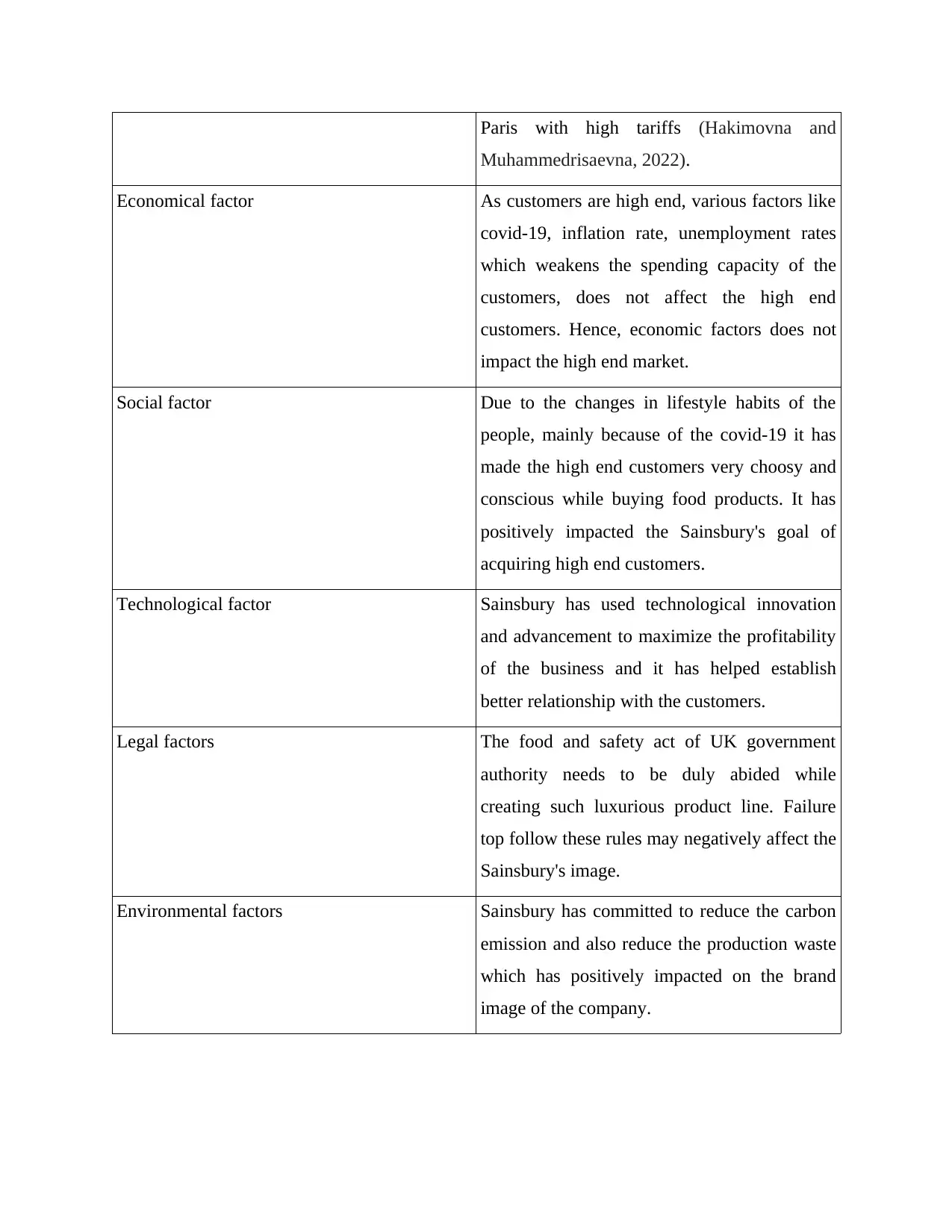
Paris with high tariffs (Hakimovna and
Muhammedrisaevna, 2022).
Economical factor As customers are high end, various factors like
covid-19, inflation rate, unemployment rates
which weakens the spending capacity of the
customers, does not affect the high end
customers. Hence, economic factors does not
impact the high end market.
Social factor Due to the changes in lifestyle habits of the
people, mainly because of the covid-19 it has
made the high end customers very choosy and
conscious while buying food products. It has
positively impacted the Sainsbury's goal of
acquiring high end customers.
Technological factor Sainsbury has used technological innovation
and advancement to maximize the profitability
of the business and it has helped establish
better relationship with the customers.
Legal factors The food and safety act of UK government
authority needs to be duly abided while
creating such luxurious product line. Failure
top follow these rules may negatively affect the
Sainsbury's image.
Environmental factors Sainsbury has committed to reduce the carbon
emission and also reduce the production waste
which has positively impacted on the brand
image of the company.
Muhammedrisaevna, 2022).
Economical factor As customers are high end, various factors like
covid-19, inflation rate, unemployment rates
which weakens the spending capacity of the
customers, does not affect the high end
customers. Hence, economic factors does not
impact the high end market.
Social factor Due to the changes in lifestyle habits of the
people, mainly because of the covid-19 it has
made the high end customers very choosy and
conscious while buying food products. It has
positively impacted the Sainsbury's goal of
acquiring high end customers.
Technological factor Sainsbury has used technological innovation
and advancement to maximize the profitability
of the business and it has helped establish
better relationship with the customers.
Legal factors The food and safety act of UK government
authority needs to be duly abided while
creating such luxurious product line. Failure
top follow these rules may negatively affect the
Sainsbury's image.
Environmental factors Sainsbury has committed to reduce the carbon
emission and also reduce the production waste
which has positively impacted on the brand
image of the company.
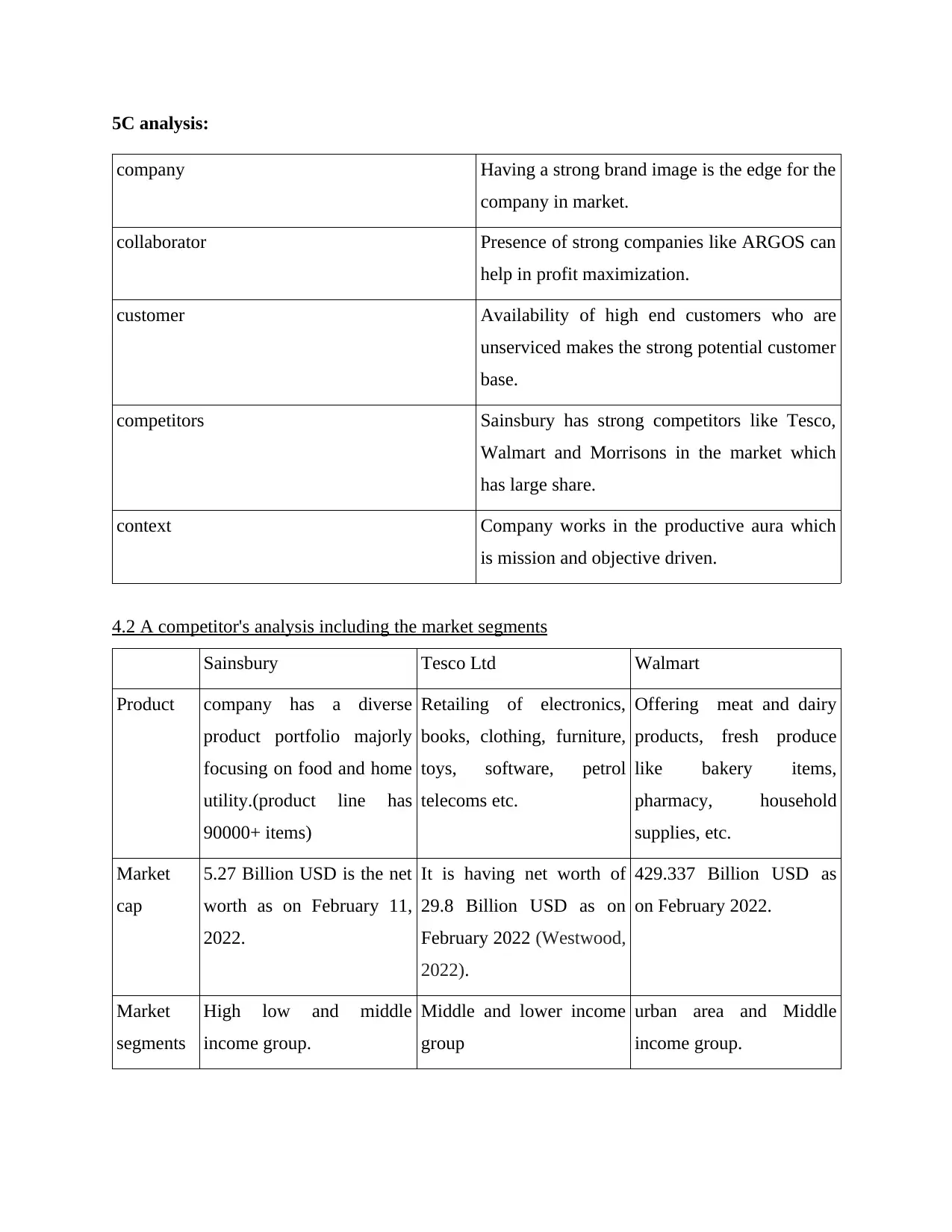
5C analysis:
company Having a strong brand image is the edge for the
company in market.
collaborator Presence of strong companies like ARGOS can
help in profit maximization.
customer Availability of high end customers who are
unserviced makes the strong potential customer
base.
competitors Sainsbury has strong competitors like Tesco,
Walmart and Morrisons in the market which
has large share.
context Company works in the productive aura which
is mission and objective driven.
4.2 A competitor's analysis including the market segments
Sainsbury Tesco Ltd Walmart
Product company has a diverse
product portfolio majorly
focusing on food and home
utility.(product line has
90000+ items)
Retailing of electronics,
books, clothing, furniture,
toys, software, petrol
telecoms etc.
Offering meat and dairy
products, fresh produce
like bakery items,
pharmacy, household
supplies, etc.
Market
cap
5.27 Billion USD is the net
worth as on February 11,
2022.
It is having net worth of
29.8 Billion USD as on
February 2022 (Westwood,
2022).
429.337 Billion USD as
on February 2022.
Market
segments
High low and middle
income group.
Middle and lower income
group
urban area and Middle
income group.
company Having a strong brand image is the edge for the
company in market.
collaborator Presence of strong companies like ARGOS can
help in profit maximization.
customer Availability of high end customers who are
unserviced makes the strong potential customer
base.
competitors Sainsbury has strong competitors like Tesco,
Walmart and Morrisons in the market which
has large share.
context Company works in the productive aura which
is mission and objective driven.
4.2 A competitor's analysis including the market segments
Sainsbury Tesco Ltd Walmart
Product company has a diverse
product portfolio majorly
focusing on food and home
utility.(product line has
90000+ items)
Retailing of electronics,
books, clothing, furniture,
toys, software, petrol
telecoms etc.
Offering meat and dairy
products, fresh produce
like bakery items,
pharmacy, household
supplies, etc.
Market
cap
5.27 Billion USD is the net
worth as on February 11,
2022.
It is having net worth of
29.8 Billion USD as on
February 2022 (Westwood,
2022).
429.337 Billion USD as
on February 2022.
Market
segments
High low and middle
income group.
Middle and lower income
group
urban area and Middle
income group.

4.3 Sub segments
Company is launching the new luxurious product line targetting the high end customers.
Yet there is sub segment present in the high end market which is division on the basis of
expectations from the Sainsbury's product line. Those bases of sub segment is expectation of
customer regarding quality, taste, health benefits, ingredients, veganism etc. therefore products
should be marketed in a way that it attracts everyone in the high income group.
4.4 articulation of the new product value proposition in the eyes of the customer
Sainsbury believes in making its products available and accessible to every income group
yet the high focus for this luxurious products remain on the high income group people. For
achieving this Sainsbury is putting the product line in such a way that it attracts everyone no
matter the income group customer belongs to. As customer should be compelled enough by the
proposition, that cost does not even matter any more. Therefore, value for quality turns out to be
the best way of propositioning the products in customers eyes.
4.5 development of the marketing strategies applied to the extended marketing mix
Three elements of extended marketing mix are people, process and physical evidence.
People, anyone who is going to represent the Sainsbury by interacting directly or indirectly with
the high end customers must be given proper training which enlightens them about customer
satisfaction and how to serve these customers (Chernev, 2020). Process, starting from the time
when custom er comes into contact with the brand till the time they make purchase and even
beyond that every interaction must be made effective and efficient that customer should feel
treated nicely. Physical evidence, by having celebrities who can nicely endorse the luxurious
product line as this will ensure great reliability and commitment in the company's part.
4.6 setting of an overall marketing budget, including allocation of planned spend
Particulars amount
salaries £ 15000
Advertising (including social media) £ 70000
Feedbacks, customer input £ 6000
Customer service £ 9500
Nector membership £ 9000
Company is launching the new luxurious product line targetting the high end customers.
Yet there is sub segment present in the high end market which is division on the basis of
expectations from the Sainsbury's product line. Those bases of sub segment is expectation of
customer regarding quality, taste, health benefits, ingredients, veganism etc. therefore products
should be marketed in a way that it attracts everyone in the high income group.
4.4 articulation of the new product value proposition in the eyes of the customer
Sainsbury believes in making its products available and accessible to every income group
yet the high focus for this luxurious products remain on the high income group people. For
achieving this Sainsbury is putting the product line in such a way that it attracts everyone no
matter the income group customer belongs to. As customer should be compelled enough by the
proposition, that cost does not even matter any more. Therefore, value for quality turns out to be
the best way of propositioning the products in customers eyes.
4.5 development of the marketing strategies applied to the extended marketing mix
Three elements of extended marketing mix are people, process and physical evidence.
People, anyone who is going to represent the Sainsbury by interacting directly or indirectly with
the high end customers must be given proper training which enlightens them about customer
satisfaction and how to serve these customers (Chernev, 2020). Process, starting from the time
when custom er comes into contact with the brand till the time they make purchase and even
beyond that every interaction must be made effective and efficient that customer should feel
treated nicely. Physical evidence, by having celebrities who can nicely endorse the luxurious
product line as this will ensure great reliability and commitment in the company's part.
4.6 setting of an overall marketing budget, including allocation of planned spend
Particulars amount
salaries £ 15000
Advertising (including social media) £ 70000
Feedbacks, customer input £ 6000
Customer service £ 9500
Nector membership £ 9000
Paraphrase This Document
Need a fresh take? Get an instant paraphrase of this document with our AI Paraphraser
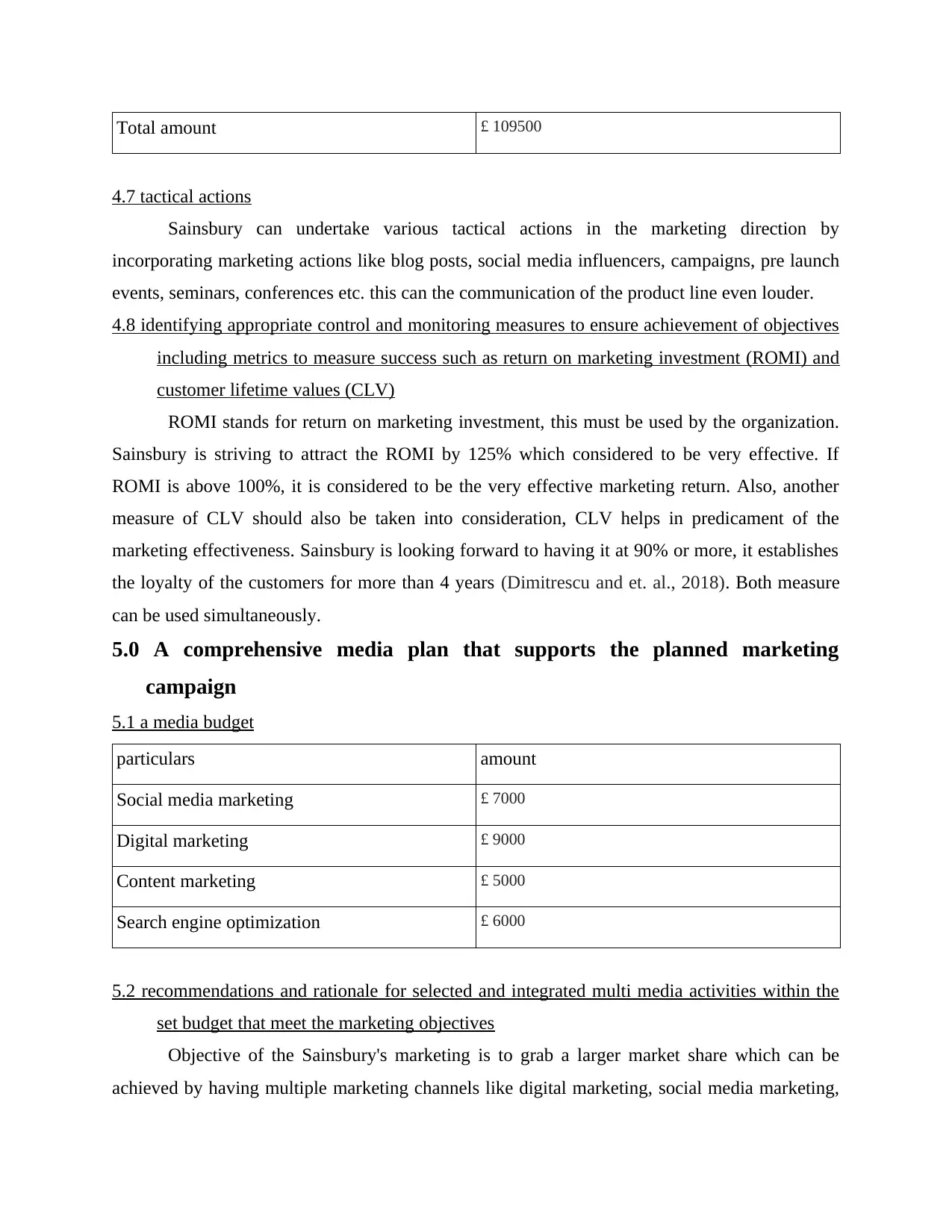
Total amount £ 109500
4.7 tactical actions
Sainsbury can undertake various tactical actions in the marketing direction by
incorporating marketing actions like blog posts, social media influencers, campaigns, pre launch
events, seminars, conferences etc. this can the communication of the product line even louder.
4.8 identifying appropriate control and monitoring measures to ensure achievement of objectives
including metrics to measure success such as return on marketing investment (ROMI) and
customer lifetime values (CLV)
ROMI stands for return on marketing investment, this must be used by the organization.
Sainsbury is striving to attract the ROMI by 125% which considered to be very effective. If
ROMI is above 100%, it is considered to be the very effective marketing return. Also, another
measure of CLV should also be taken into consideration, CLV helps in predicament of the
marketing effectiveness. Sainsbury is looking forward to having it at 90% or more, it establishes
the loyalty of the customers for more than 4 years (Dimitrescu and et. al., 2018). Both measure
can be used simultaneously.
5.0 A comprehensive media plan that supports the planned marketing
campaign
5.1 a media budget
particulars amount
Social media marketing £ 7000
Digital marketing £ 9000
Content marketing £ 5000
Search engine optimization £ 6000
5.2 recommendations and rationale for selected and integrated multi media activities within the
set budget that meet the marketing objectives
Objective of the Sainsbury's marketing is to grab a larger market share which can be
achieved by having multiple marketing channels like digital marketing, social media marketing,
4.7 tactical actions
Sainsbury can undertake various tactical actions in the marketing direction by
incorporating marketing actions like blog posts, social media influencers, campaigns, pre launch
events, seminars, conferences etc. this can the communication of the product line even louder.
4.8 identifying appropriate control and monitoring measures to ensure achievement of objectives
including metrics to measure success such as return on marketing investment (ROMI) and
customer lifetime values (CLV)
ROMI stands for return on marketing investment, this must be used by the organization.
Sainsbury is striving to attract the ROMI by 125% which considered to be very effective. If
ROMI is above 100%, it is considered to be the very effective marketing return. Also, another
measure of CLV should also be taken into consideration, CLV helps in predicament of the
marketing effectiveness. Sainsbury is looking forward to having it at 90% or more, it establishes
the loyalty of the customers for more than 4 years (Dimitrescu and et. al., 2018). Both measure
can be used simultaneously.
5.0 A comprehensive media plan that supports the planned marketing
campaign
5.1 a media budget
particulars amount
Social media marketing £ 7000
Digital marketing £ 9000
Content marketing £ 5000
Search engine optimization £ 6000
5.2 recommendations and rationale for selected and integrated multi media activities within the
set budget that meet the marketing objectives
Objective of the Sainsbury's marketing is to grab a larger market share which can be
achieved by having multiple marketing channels like digital marketing, social media marketing,
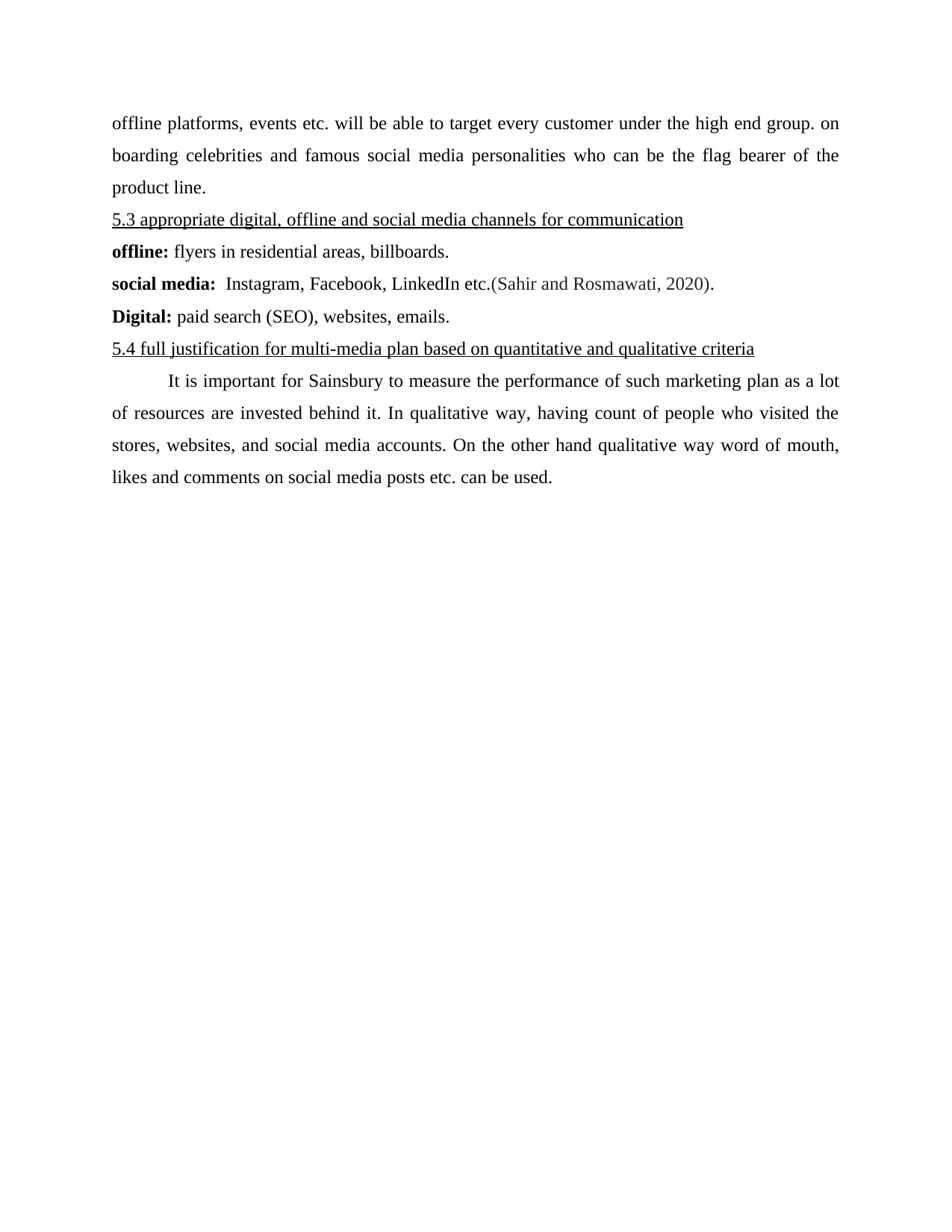
offline platforms, events etc. will be able to target every customer under the high end group. on
boarding celebrities and famous social media personalities who can be the flag bearer of the
product line.
5.3 appropriate digital, offline and social media channels for communication
offline: flyers in residential areas, billboards.
social media: Instagram, Facebook, LinkedIn etc.(Sahir and Rosmawati, 2020).
Digital: paid search (SEO), websites, emails.
5.4 full justification for multi-media plan based on quantitative and qualitative criteria
It is important for Sainsbury to measure the performance of such marketing plan as a lot
of resources are invested behind it. In qualitative way, having count of people who visited the
stores, websites, and social media accounts. On the other hand qualitative way word of mouth,
likes and comments on social media posts etc. can be used.
boarding celebrities and famous social media personalities who can be the flag bearer of the
product line.
5.3 appropriate digital, offline and social media channels for communication
offline: flyers in residential areas, billboards.
social media: Instagram, Facebook, LinkedIn etc.(Sahir and Rosmawati, 2020).
Digital: paid search (SEO), websites, emails.
5.4 full justification for multi-media plan based on quantitative and qualitative criteria
It is important for Sainsbury to measure the performance of such marketing plan as a lot
of resources are invested behind it. In qualitative way, having count of people who visited the
stores, websites, and social media accounts. On the other hand qualitative way word of mouth,
likes and comments on social media posts etc. can be used.
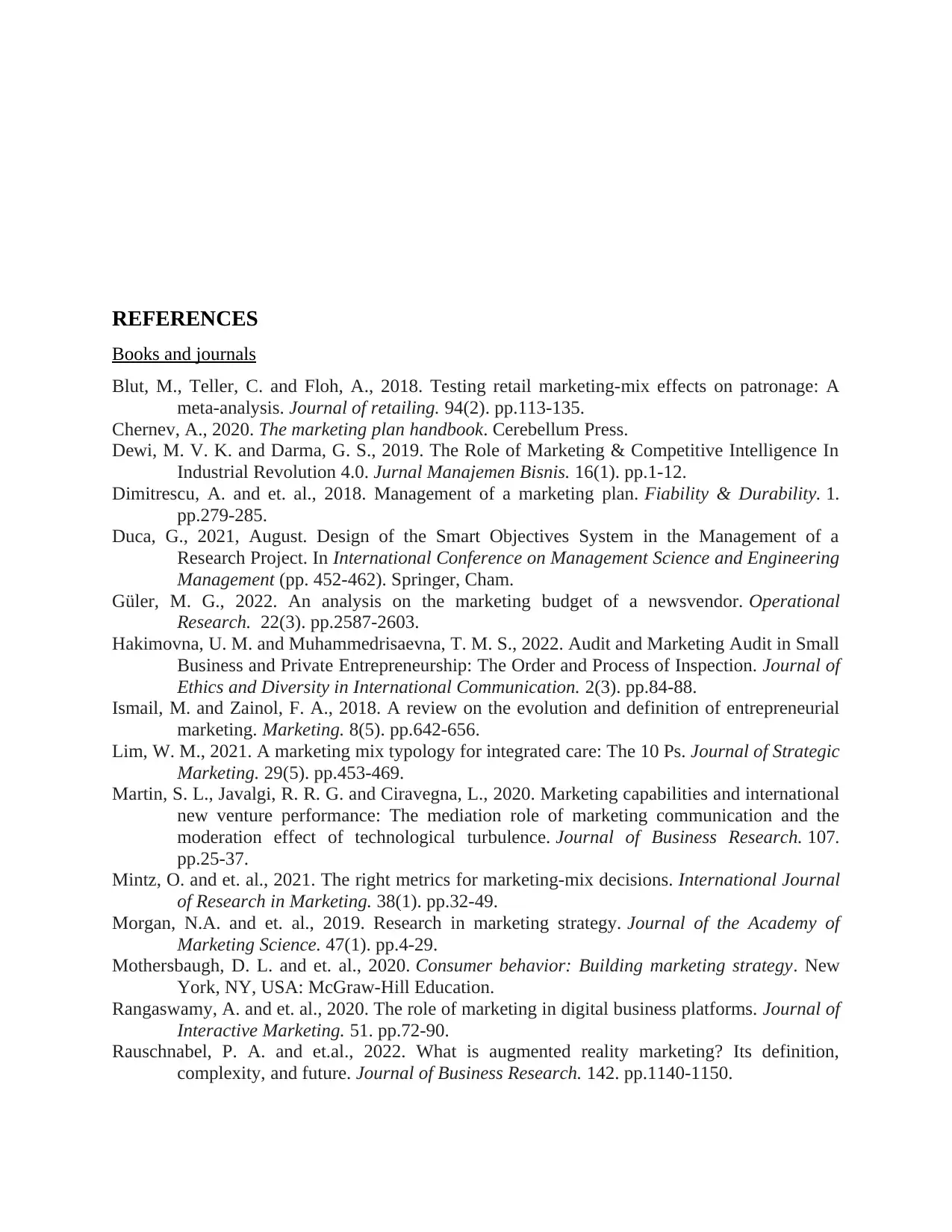
REFERENCES
Books and journals
Blut, M., Teller, C. and Floh, A., 2018. Testing retail marketing-mix effects on patronage: A
meta-analysis. Journal of retailing. 94(2). pp.113-135.
Chernev, A., 2020. The marketing plan handbook. Cerebellum Press.
Dewi, M. V. K. and Darma, G. S., 2019. The Role of Marketing & Competitive Intelligence In
Industrial Revolution 4.0. Jurnal Manajemen Bisnis. 16(1). pp.1-12.
Dimitrescu, A. and et. al., 2018. Management of a marketing plan. Fiability & Durability. 1.
pp.279-285.
Duca, G., 2021, August. Design of the Smart Objectives System in the Management of a
Research Project. In International Conference on Management Science and Engineering
Management (pp. 452-462). Springer, Cham.
Güler, M. G., 2022. An analysis on the marketing budget of a newsvendor. Operational
Research. 22(3). pp.2587-2603.
Hakimovna, U. M. and Muhammedrisaevna, T. M. S., 2022. Audit and Marketing Audit in Small
Business and Private Entrepreneurship: The Order and Process of Inspection. Journal of
Ethics and Diversity in International Communication. 2(3). pp.84-88.
Ismail, M. and Zainol, F. A., 2018. A review on the evolution and definition of entrepreneurial
marketing. Marketing. 8(5). pp.642-656.
Lim, W. M., 2021. A marketing mix typology for integrated care: The 10 Ps. Journal of Strategic
Marketing. 29(5). pp.453-469.
Martin, S. L., Javalgi, R. R. G. and Ciravegna, L., 2020. Marketing capabilities and international
new venture performance: The mediation role of marketing communication and the
moderation effect of technological turbulence. Journal of Business Research. 107.
pp.25-37.
Mintz, O. and et. al., 2021. The right metrics for marketing-mix decisions. International Journal
of Research in Marketing. 38(1). pp.32-49.
Morgan, N.A. and et. al., 2019. Research in marketing strategy. Journal of the Academy of
Marketing Science. 47(1). pp.4-29.
Mothersbaugh, D. L. and et. al., 2020. Consumer behavior: Building marketing strategy. New
York, NY, USA: McGraw-Hill Education.
Rangaswamy, A. and et. al., 2020. The role of marketing in digital business platforms. Journal of
Interactive Marketing. 51. pp.72-90.
Rauschnabel, P. A. and et.al., 2022. What is augmented reality marketing? Its definition,
complexity, and future. Journal of Business Research. 142. pp.1140-1150.
Books and journals
Blut, M., Teller, C. and Floh, A., 2018. Testing retail marketing-mix effects on patronage: A
meta-analysis. Journal of retailing. 94(2). pp.113-135.
Chernev, A., 2020. The marketing plan handbook. Cerebellum Press.
Dewi, M. V. K. and Darma, G. S., 2019. The Role of Marketing & Competitive Intelligence In
Industrial Revolution 4.0. Jurnal Manajemen Bisnis. 16(1). pp.1-12.
Dimitrescu, A. and et. al., 2018. Management of a marketing plan. Fiability & Durability. 1.
pp.279-285.
Duca, G., 2021, August. Design of the Smart Objectives System in the Management of a
Research Project. In International Conference on Management Science and Engineering
Management (pp. 452-462). Springer, Cham.
Güler, M. G., 2022. An analysis on the marketing budget of a newsvendor. Operational
Research. 22(3). pp.2587-2603.
Hakimovna, U. M. and Muhammedrisaevna, T. M. S., 2022. Audit and Marketing Audit in Small
Business and Private Entrepreneurship: The Order and Process of Inspection. Journal of
Ethics and Diversity in International Communication. 2(3). pp.84-88.
Ismail, M. and Zainol, F. A., 2018. A review on the evolution and definition of entrepreneurial
marketing. Marketing. 8(5). pp.642-656.
Lim, W. M., 2021. A marketing mix typology for integrated care: The 10 Ps. Journal of Strategic
Marketing. 29(5). pp.453-469.
Martin, S. L., Javalgi, R. R. G. and Ciravegna, L., 2020. Marketing capabilities and international
new venture performance: The mediation role of marketing communication and the
moderation effect of technological turbulence. Journal of Business Research. 107.
pp.25-37.
Mintz, O. and et. al., 2021. The right metrics for marketing-mix decisions. International Journal
of Research in Marketing. 38(1). pp.32-49.
Morgan, N.A. and et. al., 2019. Research in marketing strategy. Journal of the Academy of
Marketing Science. 47(1). pp.4-29.
Mothersbaugh, D. L. and et. al., 2020. Consumer behavior: Building marketing strategy. New
York, NY, USA: McGraw-Hill Education.
Rangaswamy, A. and et. al., 2020. The role of marketing in digital business platforms. Journal of
Interactive Marketing. 51. pp.72-90.
Rauschnabel, P. A. and et.al., 2022. What is augmented reality marketing? Its definition,
complexity, and future. Journal of Business Research. 142. pp.1140-1150.
Secure Best Marks with AI Grader
Need help grading? Try our AI Grader for instant feedback on your assignments.
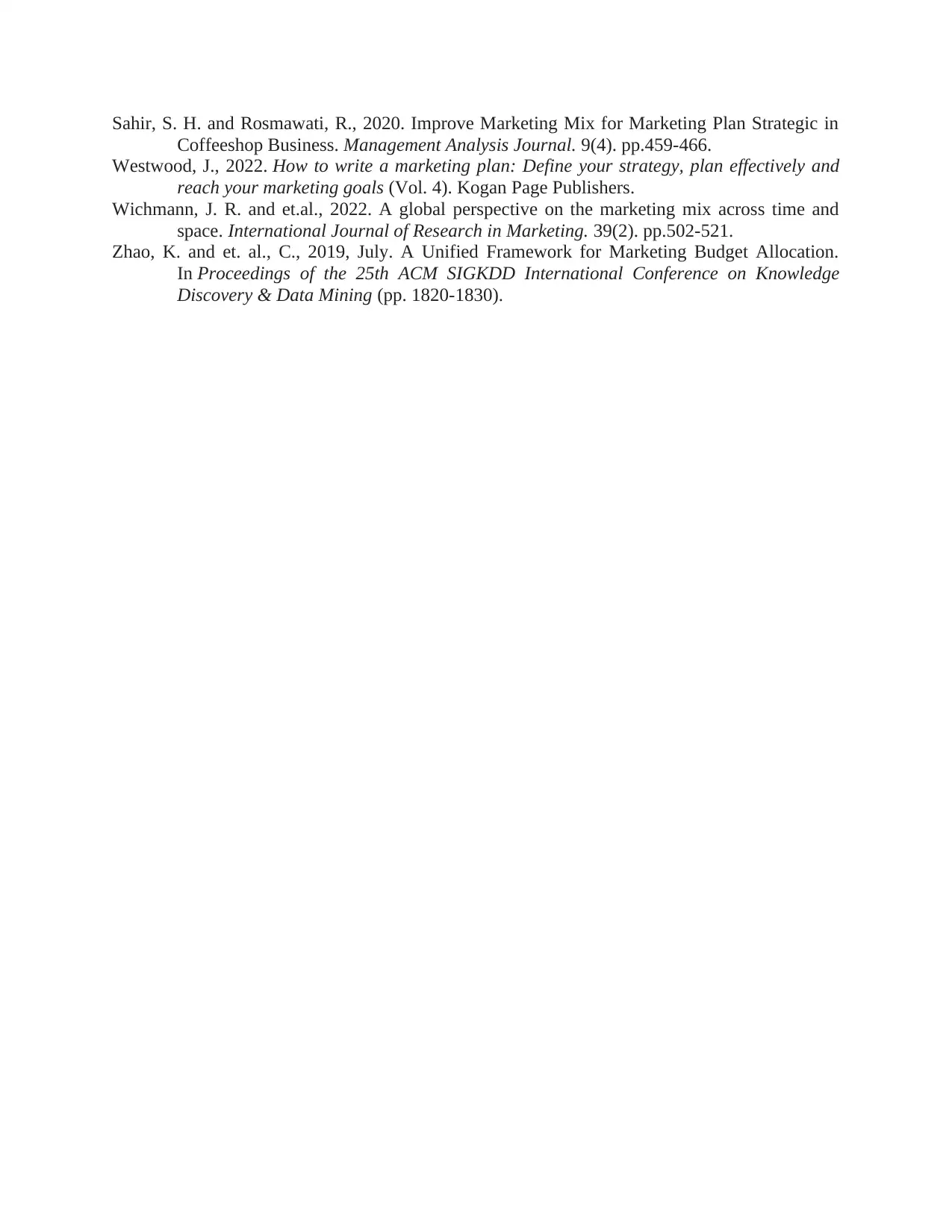
Sahir, S. H. and Rosmawati, R., 2020. Improve Marketing Mix for Marketing Plan Strategic in
Coffeeshop Business. Management Analysis Journal. 9(4). pp.459-466.
Westwood, J., 2022. How to write a marketing plan: Define your strategy, plan effectively and
reach your marketing goals (Vol. 4). Kogan Page Publishers.
Wichmann, J. R. and et.al., 2022. A global perspective on the marketing mix across time and
space. International Journal of Research in Marketing. 39(2). pp.502-521.
Zhao, K. and et. al., C., 2019, July. A Unified Framework for Marketing Budget Allocation.
In Proceedings of the 25th ACM SIGKDD International Conference on Knowledge
Discovery & Data Mining (pp. 1820-1830).
Coffeeshop Business. Management Analysis Journal. 9(4). pp.459-466.
Westwood, J., 2022. How to write a marketing plan: Define your strategy, plan effectively and
reach your marketing goals (Vol. 4). Kogan Page Publishers.
Wichmann, J. R. and et.al., 2022. A global perspective on the marketing mix across time and
space. International Journal of Research in Marketing. 39(2). pp.502-521.
Zhao, K. and et. al., C., 2019, July. A Unified Framework for Marketing Budget Allocation.
In Proceedings of the 25th ACM SIGKDD International Conference on Knowledge
Discovery & Data Mining (pp. 1820-1830).
1 out of 17
Related Documents
Your All-in-One AI-Powered Toolkit for Academic Success.
+13062052269
info@desklib.com
Available 24*7 on WhatsApp / Email
![[object Object]](/_next/static/media/star-bottom.7253800d.svg)
Unlock your academic potential
© 2024 | Zucol Services PVT LTD | All rights reserved.

